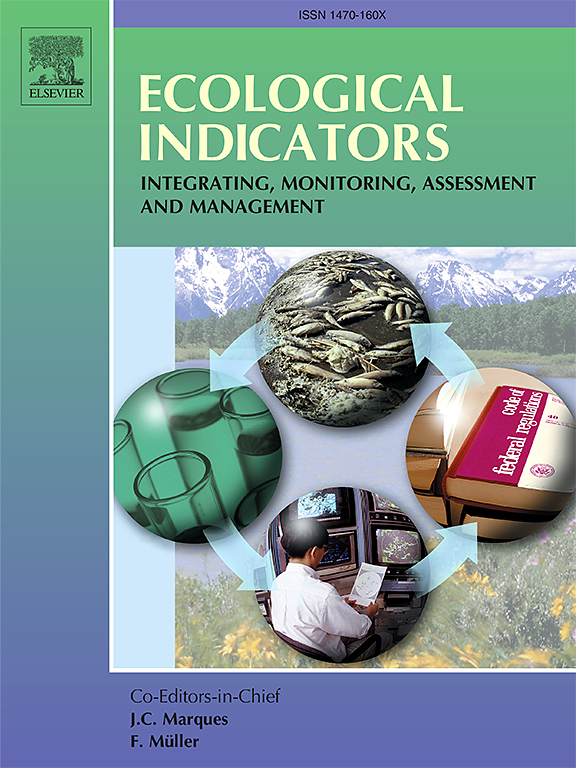沿海泻湖生态健康评价的综合方法:以智利中部海燕泻湖为例
IF 7
2区 环境科学与生态学
Q1 ENVIRONMENTAL SCIENCES
引用次数: 0
摘要
沿海水生生态系统是高度动态的,并受到多种自然和人为因素的影响,这些因素可能导致其退化。在这项研究中,我们提出了一种创新的跨学科方法,将位于智利中部的圣安东尼奥河和海螺泻湖的物理化学性质、金属浓度和微生物群落的分析整合在一起,以评估该沿海生态系统的生态健康。营养物浓度,特别是NO3−(值范围为26.6±0.0和37.6±9.4 mg/L)和PO42−(值>;8.0 mg/L),反映了农业投入,而微生物指标(大肠杆菌)在几个地点超过了监管阈值(> 1000 mpn /100 ml)。金属分析显示Na和Mg的浓度很高(2000 Mg /L和2000 Mg /L)。(分别为280毫克/升),以及沉积物中的Al、Fe和Li(值范围从20,000到1.0x106毫克/公斤)。水体微生物群落分析表明,大部分站点以Idiomarinaceae(占总群落的16%)和Marinicella(占总群落的5%)为主,下游站点以Owenweeksia(占总群落的12%)富集。检测到潜在的致病属,包括痤疮表皮杆菌,提示对水质和公共卫生的风险。多变量分析揭示了盐度和养分输入驱动的空间结构,强调了水动力和土地利用的影响。这些发现突出了显著的环境梯度和污染热点,强调需要一种综合方法,将类似的方法整合在一起,以更好地了解微生物动力学、金属行为及其对水质的综合影响。未来的研究应旨在克服这项工作的局限性,以便确定相关指标并制定支持生态系统服务可持续性的有效监测战略。本文章由计算机程序翻译,如有差异,请以英文原文为准。
Comprehensive approach to coastal lagoon ecological health evaluation: Example of Petrel Lagoon, Central Chile
Coastal aquatic ecosystems are highly dynamic and influenced by multiple natural and anthropogenic factors that can contribute to their degradation. In this study, we present an innovative and interdisciplinary approach that integrates the analysis of the physicochemical properties, metal concentrations, and microbial communities in the San Antonio River and Petrel Lagoon, located in Central Chile, to evaluate the ecological health of this coastal ecosystem. Nutrient concentrations, in particular NO3− (values ranged from 26.6 ± 0.0 and 37.6 ± 9.4 mg/L) and PO42− (values > 8.0 mg/L), were elevated upstream, reflecting agricultural inputs, while microbial indicators (E. coli) surpassed regulatory thresholds (>1,000MPN/100 ml) in several sites. Metal analyses revealed high Na and Mg, concentrations (>2,000 mg/L and > 280 mg/L, respectively) in waters and in Al, Fe and Li in sediments (values ranged from 20,000 to 1.0x106 mg/kg). Microbial community analyses in waters identified that most of the sites were dominated by Idiomarinaceae (16 % of total community) and Marinicella (5 % of total community), and with enrichment in Owenweeksia (12 % of total community) in downstream sites. Potential pathogenic genera, including Cutibacterium acnes, were detected, suggesting risks to water quality and public health. Multivariate analyses revealed spatial structuring driven by salinity and nutrient inputs, emphasizing the influence of hydrodynamics and land use. These findings highlight significant environmental gradients and contamination hotspots, stressing the need for a comprehensive approach that integrates a similar approach to better understand microbial dynamics, metal behavior, and their combined impact on water quality. Future studies should aim to overcome the limitations of this work in order to identify relevant indicators and develop effective monitoring strategies that support the sustainability of ecosystem services.
求助全文
通过发布文献求助,成功后即可免费获取论文全文。
去求助
来源期刊

Ecological Indicators
环境科学-环境科学
CiteScore
11.80
自引率
8.70%
发文量
1163
审稿时长
78 days
期刊介绍:
The ultimate aim of Ecological Indicators is to integrate the monitoring and assessment of ecological and environmental indicators with management practices. The journal provides a forum for the discussion of the applied scientific development and review of traditional indicator approaches as well as for theoretical, modelling and quantitative applications such as index development. Research into the following areas will be published.
• All aspects of ecological and environmental indicators and indices.
• New indicators, and new approaches and methods for indicator development, testing and use.
• Development and modelling of indices, e.g. application of indicator suites across multiple scales and resources.
• Analysis and research of resource, system- and scale-specific indicators.
• Methods for integration of social and other valuation metrics for the production of scientifically rigorous and politically-relevant assessments using indicator-based monitoring and assessment programs.
• How research indicators can be transformed into direct application for management purposes.
• Broader assessment objectives and methods, e.g. biodiversity, biological integrity, and sustainability, through the use of indicators.
• Resource-specific indicators such as landscape, agroecosystems, forests, wetlands, etc.
 求助内容:
求助内容: 应助结果提醒方式:
应助结果提醒方式:


